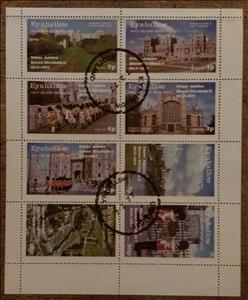Mini Sheet: Siver Jubilee Queen Elizabeth II 1952-1977 (Cinderellas 1977)
Siver Jubilee Queen Elizabeth II 1952-1977 (Cinderellas 1977)
01 January (Cinderellas ) within release Eynhallow Holy Island, Scotland goes into circulation Mini Sheet Siver Jubilee Queen Elizabeth II 1952-1977 face value 70 British penny
| Mini Sheet Siver Jubilee Queen Elizabeth II 1952-1977 in catalogues | |
|---|---|
| Colnect codes: | Col: HI 1977-06A |
Mini Sheet is square format.
Also in the issue Eynhallow Holy Island, Scotland:
- Mini Sheet - Animals face value 100;
- Stamp - Marmot face value 4;
- Mini Sheet - Siver Jubilee Queen Elizabeth II 1952-1977 face value 70;
- Stamp - Bear face value 20;
- Stamp - Camel face value 30;
- Stamp - Llama face value 2;
- Stamp - Monkey face value 1;
- Stamp - Penguins face value 3;
- Stamp - Siver Jubilee Queen Elizabeth II 1952-1977 face value 1;
- Stamp - Moose face value 15;
- Stamp - Brown Bear face value 3;
- Stamp - Wolf face value 2;
- Stamp - Bison face value 20;
- Stamp - Siver Jubilee Queen Elizabeth II 1952-1977 face value 4;
- Stamp - Alligator face value 30;
- Stamp - Siver Jubilee Queen Elizabeth II 1952-1977 face value 5;
- Mini Sheet - Animal Series. North America face value 1;
- Stamp - Beaver face value 25;
- Mini Sheet - Siver Jubilee Queen Elizabeth II 1952-1977 face value 70;
- Stamp - Siver Jubilee Queen Elizabeth II 1952-1977 face value 25;
- Stamp - Siver Jubilee Queen Elizabeth II 1952-1977 face value 3;
- Stamp - Raccoon face value 1;
- Stamp - Siver Jubilee Queen Elizabeth II 1952-1977 face value 15;
- Stamp - Bob cat face value 4;
- Stamp - Siver Jubilee Queen Elizabeth II 1952-1977 face value 2;
- Stamp - Siver Jubilee Queen Elizabeth II 1952-1977 face value 20;
Mini Sheet Siver Jubilee Queen Elizabeth II 1952-1977 it reflects the thematic directions:
An anniversary is the date on which an event took place or an institution was founded in a previous year, and may also refer to the commemoration or celebration of that event. For example, the first event is the initial occurrence or, if planned, the inaugural of the event. One year later would be the first anniversary of that event. The word was first used for Catholic feasts to commemorate saints. Most countries celebrate national anniversaries, typically called national days. These could be the date of independence of the nation or the adoption of a new constitution or form of government. The important dates in a sitting monarch's reign may also be commemorated, an event often referred to as a "Jubilee".
A castle (from Latin: castellum) is a type of fortified structure built in Europe and the Middle East during the Middle Ages by European nobility. Scholars debate the scope of the word castle, but usually consider it to be the private fortified residence of a lord or noble. This is distinct from a palace, which is not fortified; from a fortress, which was not always a residence for nobility; and from a fortified settlement, which was a public defence – though there are many similarities among these types of construction. Usage of the term has varied over time and has been applied to structures as diverse as hill forts and country houses. Over the approximately 900 years that castles were built, they took on a great many forms with many different features, although some, such as curtain walls and arrowslits, were commonplace.
A church building, often simply called a church, is a building used for Christian religious activities, particularly worship services. The term in its architectural sense is most often used by Christians to refer to their religious buildings, but it is sometimes used (by analogy) for buildings of other religions. In traditional Christian architecture, the church is often arranged in the shape of a Christian cross. When viewed from plan view the longest part of a cross is represented by the aisle and the junction of the cross is located at the altar area. Towers or domes are often added with the intention of directing the eye of the viewer towards the heavens and inspiring church visitors. Modern church buildings have a variety of architectural styles and layouts; many buildings that were designed for other purposes have now been converted for church use; and, similarly, many original church buildings have been put to other uses. The earliest identified Christian church was a house church founded between 233 and 256. During the 11th through 14th centuries, a wave of building of cathedrals and smaller parish churches occurred across Western Europe. A cathedral is a church, usually Roman Catholic, Anglican, Oriental Orthodox or Eastern Orthodox, housing the seat of a bishop.



